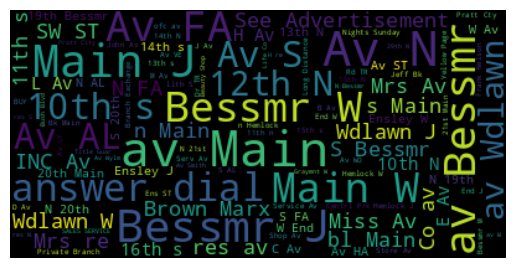LoC Data Package Tutorial: Digitized Telephone Directories Data Package#
This notebook will demonstrate basic usage of using Python for interacting with data packages from the Library of Congress via the Digitized Telephone Directories Data Package which is derived from the Library’s U.S. Telephone Directory Collection. We will:
Prerequisites#
In order to run this notebook, please follow the instructions listed in this directory’s README.
Output data package summary#
First we will output a summary of the Digitized Telephone Directories Data Package contents
import io
import pandas as pd # for reading, manipulating, and displaying data
import requests
from helpers import get_file_stats
DATA_URL = 'https://data.labs.loc.gov/telephone/' # Base URL of this data package
# Download the file manifest
file_manifest_url = f'{DATA_URL}manifest.json'
response = requests.get(file_manifest_url, timeout=60)
response_json = response.json()
files = [dict(zip(response_json["cols"], row)) for row in response_json["rows"]] # zip columns and rows
# Convert to Pandas DataFrame and show stats table
stats = get_file_stats(files)
pd.DataFrame(stats)
| FileType | Count | Size | |
|---|---|---|---|
| 0 | .txt | 486 | 2.37GB |
Query the metadata in a data package#
Next we will download a data package’s metadata, print a summary of the items’ subject values, then filter by a particular location.
All data packages have a metadata file in .json and .csv formats. Let’s load the data package’s metadata.json file:
metadata_url = f'{DATA_URL}metadata.json'
response = requests.get(metadata_url, timeout=60)
data = response.json()
print(f'Loaded metadata file with {len(data):,} entries.')
Loaded metadata file with 3,511 entries.
Next let’s convert to pandas DataFrame and print the available properties
df = pd.DataFrame(data)
print(', '.join(df.columns.to_list()))
Date_text, Date, Digitized, Id, IIIF_manifest, Preview_url, Call_number, Type_of_resource, Genre, Location_text, Original_format, Repository, Rights, Source_collection, Title, Mime_type, Online_format, Part_of, Number_of_files, Shelf_id, Url, Last_updated_in_api, Language, Location, Location_ocr
Next print the top 10 most frequent Locations in this dataset
# Since "Locations" are a list, we must "explode" it so there's just one location per row
# We convert to DataFrame so it displays as a table
df['Location_text'].explode().value_counts().iloc[:10].to_frame()
| Location_text | |
|---|---|
| United States -- Illinois -- Chicago | 131 |
| United States -- Pennsylvania -- Philadelphia | 113 |
| United States -- California -- Los Angeles Central Area | 97 |
| United States -- Alabama -- Birmingham | 74 |
| United States -- California -- Oakland | 74 |
| United States -- California -- San Francisco | 71 |
| United States -- Maryland -- Baltimore | 63 |
| United States -- California -- Sacramento | 51 |
| United States -- California -- San Diego County | 47 |
| United States -- Georgia -- Atlanta | 46 |
Now we filter the results to only those items with Location “United States – Alabama – Birmingham”
df_by_location = df.explode('Location_text')
subset = df_by_location[df_by_location.Location_text == 'United States -- Alabama -- Birmingham']
print(f'Found {subset.shape[0]:,} items with location "United States -- Alabama -- Birmingham"')
Found 74 items with location "United States -- Alabama -- Birmingham"
Download full text files and visualize it#
First we merge the subset with the text files from the manifest
df_files = pd.DataFrame(files) # Convert file manifest to DataFrame
subset_with_text = pd.merge(df_files, subset, left_on='item_id', right_on='Id', how='inner')
print(f'Found {subset_with_text.shape[0]:,} Birmingham items with text files')
Found 74 Birmingham items with text files
Next we load the OCR text
text = ''
for i, row in subset_with_text.iterrows():
file_url = f'https://{row["object_key"]}'
response = requests.get(file_url, timeout=60)
text += response.text
text += '\n'
print(f"Loaded text string of length {len(text):,}")
Loaded text string of length 308,204,743
And clean up the text by removing non-words
import re
whitespace_pattern = re.compile(r"\s+")
nonword_pattern = re.compile(r" [\S]*[\\\^<>]+[\S]* ")
tinyword_pattern = re.compile(r" [\S][\S]?[\S]? ")
text = text.replace('\\n', '')
text = whitespace_pattern.sub(" ", text).strip()
text = nonword_pattern.sub(" ", text)
text = tinyword_pattern.sub(" ", text)
text = whitespace_pattern.sub(" ", text).strip()
print(text[:100])
LIBRARY CONGRESS PRESERVATION MICROFILMING PROGRAM MATERIAL WHICH FOLLOWS FROM COMBINED COLLECTIONS
Finally generate a wordcloud using the text
import matplotlib.pyplot as plt # for displaying data
from wordcloud import WordCloud
# Generate a word cloud image
wordcloud = WordCloud(max_font_size=40).generate(text)
plt.imshow(wordcloud, interpolation='bilinear')
plt.axis("off")
(-0.5, 399.5, 199.5, -0.5)
